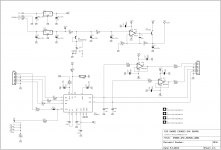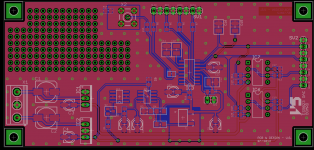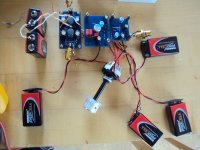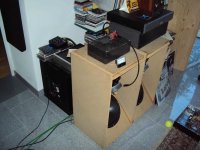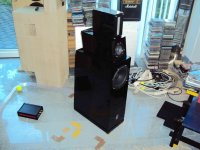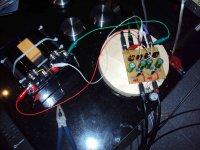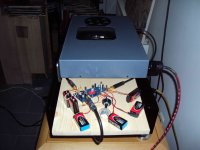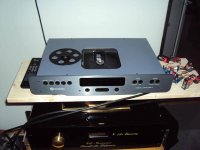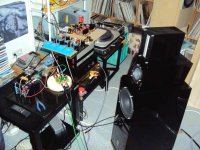thank you for advice
I guess that for ES9023 setup your batteries PSU supply at least 5 pcs low noise regulators
would you please recommend 3.3V and 5V low noise regulator
I guess that for ES9023 setup your batteries PSU supply at least 5 pcs low noise regulators
would you please recommend 3.3V and 5V low noise regulator
Just for the trial this is what I'm about to build. More info and manufacturing files on my blog 😀
DIY AUDIO BLOG : My DIY Audio Blog
DIY AUDIO BLOG : My DIY Audio Blog
Attachments
There is no reason to use extra opamps at the output IMHO.
The ES9022 already have opamps inside.
If anything you should use the Joachim Gerhard buffer.
My 2 cents,
Patrick
The ES9022 already have opamps inside.
If anything you should use the Joachim Gerhard buffer.
My 2 cents,
Patrick
Hi Patrick,
Sorry for my dumb question, is the buffer necessary if the ES9022/23 is connected to a buffer pre-amp like the B1/DCB1 ? Is the Joachim Gerhard buffer PCB available?
Thanks
Sorry for my dumb question, is the buffer necessary if the ES9022/23 is connected to a buffer pre-amp like the B1/DCB1 ? Is the Joachim Gerhard buffer PCB available?
Thanks
What normally follow the 9022 are cables and then attenuator (volume control).
Unless you have long capacitive cables, there is no reason to have an additional buffer.
The B1 or DCB1 is actually the good old source follower, i.e. a buffer.
So why would you want to add even more ?? 🙂
The reason for the Joachim Gerhard buffer is that it has additional filter before that.
The Zout of the filter is not exactly low, so a buffer can be justified here.
It is actually a more advanced, cascoded Source Follower compared to the B1.
And even if I ever need a buffer, I would not want to use an opamp in unity gain.
You might as well use a LSK389 in SOIC8, and wire it as a source follower.
We shall release a new adaptor PCB (SOIC to DIP8) specific for that purpose this summer / autumn.
As to the Joachim Gerhard filter, we can release it as soon as Joachim says yes.
Our only prototype has been sitting in his desk for a couple of weeks.
Maybe you could help us to persuade him to give it some priority.
😉
Patrick
Unless you have long capacitive cables, there is no reason to have an additional buffer.
The B1 or DCB1 is actually the good old source follower, i.e. a buffer.
So why would you want to add even more ?? 🙂
The reason for the Joachim Gerhard buffer is that it has additional filter before that.
The Zout of the filter is not exactly low, so a buffer can be justified here.
It is actually a more advanced, cascoded Source Follower compared to the B1.
And even if I ever need a buffer, I would not want to use an opamp in unity gain.
You might as well use a LSK389 in SOIC8, and wire it as a source follower.
We shall release a new adaptor PCB (SOIC to DIP8) specific for that purpose this summer / autumn.
As to the Joachim Gerhard filter, we can release it as soon as Joachim says yes.
Our only prototype has been sitting in his desk for a couple of weeks.
Maybe you could help us to persuade him to give it some priority.
😉
Patrick
Last edited:
There is no reason to use extra opamps at the output IMHO.
The ES9022 already have opamps inside.
If anything you should use the Joachim Gerhard buffer.
My 2 cents,
Patrick
I don't trust anything that is powered by 3.6V 😀 Besides the PCB has direct outputs as well. May I see a link to this "Joachim Gerhard buffer"?
Regards, Venci.
The truth is not in speculations on paper, but experience in real.
There are many who have listened to the 9022 themselves, including Joachim Gerhard.
At the top of this thread there is a search function, which will lead you to the many posts by Joachim here.
Those include the development steps of his filter.
Patrick
There are many who have listened to the 9022 themselves, including Joachim Gerhard.
At the top of this thread there is a search function, which will lead you to the many posts by Joachim here.
Those include the development steps of his filter.
Patrick
I have now connected the buffer. I run on 6 x 9V batteries.
Man is that sucker slamming ! The gain in dynamics, openness without hardness and extension is amazing. Sure one of the best sounds i got from digital.
It works without problem, no hum, no hiss, no plop, no nothing. I can highly recommend this addition. It also sounds low in distortion so the miniature coils work fine.
I have quite an awesome system at the moment. I will post more photos in a while.
I have to eat something.
Sorry to be so slow with testing. I was simply too busy until now but the wait is worth it, i promise.
Man is that sucker slamming ! The gain in dynamics, openness without hardness and extension is amazing. Sure one of the best sounds i got from digital.
It works without problem, no hum, no hiss, no plop, no nothing. I can highly recommend this addition. It also sounds low in distortion so the miniature coils work fine.
I have quite an awesome system at the moment. I will post more photos in a while.
I have to eat something.
Sorry to be so slow with testing. I was simply too busy until now but the wait is worth it, i promise.
Attachments
Last edited:
The only one we have is now with Joachim.
I don't think he is willing to part with it as yet. 🙂
But if you talk to Gogowatch nicely, I am sure he might be of some help.
Patrick
I don't think he is willing to part with it as yet. 🙂
But if you talk to Gogowatch nicely, I am sure he might be of some help.
Patrick
The only one we have is now with Joachim.
I don't think he is willing to part with it as yet. 🙂
But if you talk to Gogowatch nicely, I am sure he might be of some help.
Patrick
I will definitely like to talk to Gogowatch and beg him to help. And also can meet sometime to have lunch together.
Thanks Patrick and Joachim for coming with such nice design.
Here are some pictures of todays setup.
The first two pictures are the digital rig, Mc Cormack drive and ESS DA with buffer.
Then comes the pre amp, driven from a 6m video cable from the digital rig, then the power amp with 20W Class A, 50W AB.
The the main speakers ( Suesskind Tamgram, passive line filtered in the preamp with -3dB @ 80Hz ), the subwoofer and the analog rig with Paradise MPP R2 phono stage.
The first two pictures are the digital rig, Mc Cormack drive and ESS DA with buffer.
Then comes the pre amp, driven from a 6m video cable from the digital rig, then the power amp with 20W Class A, 50W AB.
The the main speakers ( Suesskind Tamgram, passive line filtered in the preamp with -3dB @ 80Hz ), the subwoofer and the analog rig with Paradise MPP R2 phono stage.
Attachments
- Status
- Not open for further replies.
- Home
- Source & Line
- Digital Line Level
- Anybody using the new ESS Vout DAC (ES9022)?
